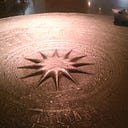Dates in Indonesian Inscriptions
The problem with pre-colonial Indo-Malaysian history, as I have endeavoured to make clear on this blog, is that there aren’t a great many primary sources, at least compared to desert or temperate Afro-Eurasia in the same period. Texts on organic materials seldom lasted long and needed to be copied regularly; the copying of early Hindu-Buddhist or indigenous religious material was interrupted to some extent by the spread of Islam in the region in the fifteenth and sixteenth centuries. The majority of texts are inscriptions, many of which feature unique scripts.* It’s difficult to reconstruct what life was actually like in medieval Indonesia from such material.
Fortunately, however, many of the early Indonesian inscriptions carry dates, and as the Hindu-Arabic positional notation system came to the archipelago in the first millennium CE most of these dates are in numerals that correspond exactly to the ones we use every day. This is one of the few uncomplicated aspects of ancient Southeast Asian philology, and we should be grateful for it.
These dates aren’t in the Christian calendar, however, but rather in Śaka years (/ˈɕəkə/, normally pronounced “SHA-ka”), a calendrical system from India based like ours on the solar year. Like much Indian cultural influence, this system came to Southeast Asia from Dravidian-speaking South India, even though the Śaka dynasty actually ruled over parts of North India and Central Asia. The South Indian form of the Śaka era began in 78 AD/CE, supposedly associated with the beginning of the reign of Caṣṭana. That means that to convert a Śaka date to a Christian/Common Era one, you just add 78.
It’s easy. The only difficulties are palaeographic: it can be difficult to figure out which numeral is which because many examples are unique. You always have to bear that in mind when looking at Indonesian texts. But let’s leave that aside for a moment and look at a simple example.

That’s an old photo of one of the inscriptions from the north side of Candi Sukuh, a peculiar fifteenth-century temple complex on the border of Central and East Java. I discussed Sukuh a little in my piece on early Indonesian scripts; as I mentioned there, it’s difficult to interpret some of the myths and stories presented in reliefs at the site, and the inscriptions are cryptic and often baffling. The dates, though, are fairly easy.
This one shows the numerals ‘1’ ‘3’ ‘6’ and ‘1’, in that order, left-to-right, just like our dates. That gives 1361 Śaka. Just add 78 and you’ve got the Christian date: 1439 CE. Easy.
To give an idea of the palaeographic complexities, though, here’s another example from Candi Singhasari. As far as I know, this script is unique, although it’s significantly easier to read at first sight than the one used at Sukuh. The numerals in the image below don’t actually give us the date of the text; the inscription was written in 1351 CE to commemorate the murder of King Kertanagara of Singhasari (here referred to as Bhaṭāra Śiwa-Buddha ‘Lord Shiva-Buddha’) in 1292 CE. The inscription is less than a century older than the Sukuh example but you’ll notice how different the script is.

What date does this represent? You may recognize the first and third characters from the left as the numeral ‘1’ by comparison with the Sukuh inscription, but the others will probably be a mystery. The complete date is 1214 Śaka (=1292 CE), the year in which Jayakatwaṅ of Kaḍiri had Kertanagara killed alongside his attendants. An important year; the Mongol army arrived soon after the murder, setting up a bizarre series of events that had a lasting impact on the development of Javanese civilization.
Indonesian chronology can otherwise be a tricky subject. Dates were sometimes spelled out in the form of words associated with particular numerals (a system known as candrasengkala), and if Indonesian history is niche, and if pre-colonial history is niche-r still, then the interpretation of candrasengkala dates is a recession in a niche in an alcove. In a crypt. The numeral ‘0’ (zero) was associated with words meaning ‘sky’, ‘not’, ‘far’, and ‘to lose’, for example, and ‘2’ (two) could be written with words for ‘friend’, ‘ear’, and ‘food’. Raffles collected a few such lists in his 1817 History of Java, and Casparis touched on the subject in his Indonesian Chronology (Leiden: Brill 1978). I defer to such authorities in attempting to read dates like these. Luckily, Indonesian translations of candrasengkala tables are readily available online as well.
More next time — on Marco Polo’s account of Java.
* The name for a text preserved in a single manuscript is codex unicus. There are plenty of codices unici in Europe and China and the term is used by philologists the world over. I’m not aware of a philological term for ‘unique script’, however, presumably because there aren’t that many of them in the material philologists typically study. It’s a particularly tropical problem, I suppose.
